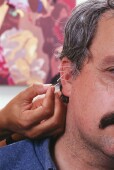- Skip Storing This Everyday Product in the Fridge Door
- Green Tea + B3 Pairing May Boost Brain Health
- Navigating Your Midlife Crisis: Embracing New Possibilities
- City Raccoons Showing Signs of Domestication
- Mapping the Exposome: Science Broadens Focus to Environmental Disease Triggers
- One Week Less on Social Media Linked to Better Mental Health
- Your Brain Changes in Stages as You Age, Study Finds
- Some Suicide Victims Show No Typical Warning Signs, Study Finds
- ByHeart Formula Faces Lawsuits After Babies Sickened With Botulism
- Switch to Vegan Diet Could Cut Your Greenhouse Gas Emissions in Half
Ear Acupuncture May Hold Promise for Weight Loss

Placing five acupuncture needles in the outer ear may help people lose that spare tire, researchers report.
Ear acupuncture therapy is based on the theory that the outer ear represents all parts of the body. One type uses one needle inserted into the area that is linked to hunger and appetite, while the other involves inserting five needles at different key points in the ear.
“If the trend we found is supported by other studies, the hunger acupuncture point is a good choice in terms of convenience. However, for patients suffering from central obesity, continuous stimulation of five acupuncture points should be used,” said lead researcher Sabina Lim, from the department of meridian and acupuncture in the Graduate College of Basic Korean Medical Science at Kyung Hee University in Seoul, South Korea.
According to Lim, the effectiveness of acupuncture on obese patients is closely related to metabolic function. “Increased metabolic function promotes the consumption of body fat, overall, resulting in weight loss,” she said.
The report was published online Dec. 16 in the journal Acupuncture in Medicine.
Dr. David Katz, director of the Yale University Prevention Research Center, said, “We must avoid rushing to judge that a treatment is ineffective just because we don’t understand the mechanism. Rather, if a treatment is genuinely effective, it invites us to figure out the mechanism.”
But this study does not prove the effectiveness of acupuncture, he said. “Placebo effects are strong, particularly when they involve needles. The evidence here falls short of proof,” Katz said.
According to the U.S. National Center for Complementary and Alternative Medicine, results from the few studies on acupuncture and weight loss have been mixed.
In one study, researchers examined the effect of ear acupuncture with sham acupuncture on obese women. “Researchers found no statistical difference in body weight, body-mass index and waist circumference between the acupuncture group and placebo,” said Katy Danielson, a spokeswoman for the center.
For this latest study, Lim and her colleagues compared acupuncture of five points on the outer ear with one-point acupuncture. They randomly assigned 91 overweight people to five-point acupuncture, one-point acupuncture (hunger) or sham (placebo) treatment.
During the eight weeks of the study, participants were told to follow a restrictive diet, but not a weight-loss diet. They were not supposed to increase their exercise.
Those who received five-point acupuncture had needles placed 2 millimeters deep in one outer ear taped in place and kept there for a week. Then the same treatment was applied to the other ear. The process was repeated over eight weeks.
Other patients received similar treatment with one needle or with sham acupuncture where the needles were removed immediately after insertion.
Over the course of the study, 24 patients dropped out, 15 of whom were receiving sham treatment, the researchers noted.
Among those who completed the study, there were significant differences in weight loss among the groups. At four weeks, those receiving five-point treatment had an average reduction in weight of 6.1 percent, compared with a 5.7 percent reduction among those treated with one needle and no weight loss among those receiving sham therapy, the researchers found.
The largest drop was seen in waist size with the five-point treatment, compared with sham therapy; however, this difference disappeared after taking age into account, the investigators noted.
Percentage of body fat also dropped, but only in those receiving the five-point treatment, the study authors added.
“Both five- and one-point approaches showed significant effects on treating the obese patients and notable reduction in the values closely related to obesity, such as waist circumference measurements and weight, compared to the sham group,” Lim said.
“But yet, the five-point approach caused the largest decrease in waist circumference, indicating that the method should be considered as a primary treatment to reduce central obesity, rather than the hunger acupuncture point or temporary stimulation of the five acupuncture points,” she pointed out.
According to the Acupuncturecost.org, treatments range in cost from $75 to $125 and are covered by some, but not all insurance companies.
More information
For more on acupuncture, visit the U.S. National Center for Complementary and Alternative Medicine.
Source: HealthDay
Copyright © 2025 HealthDay. All rights reserved.










